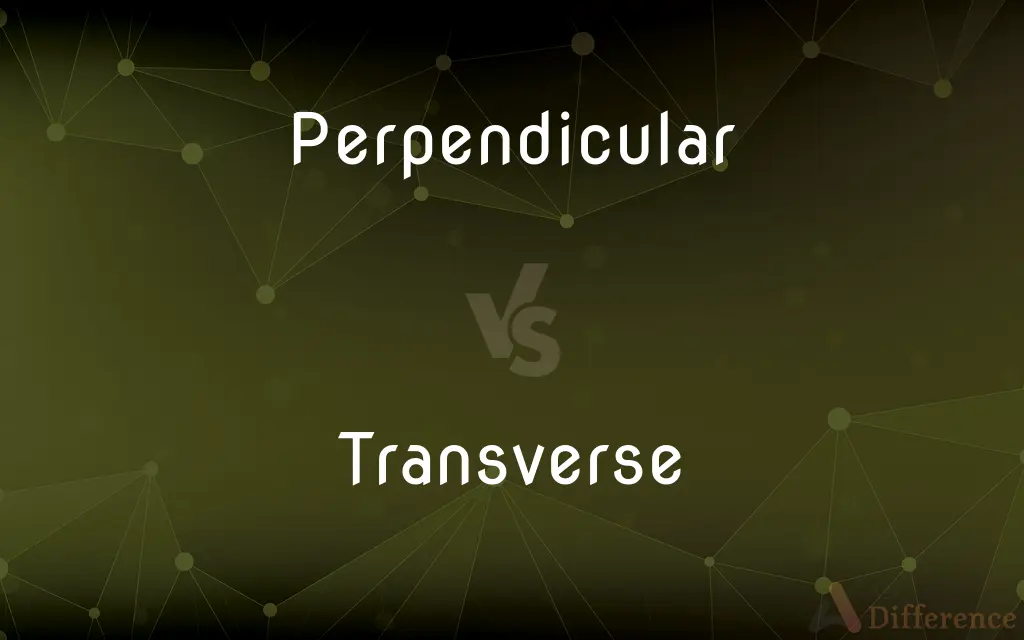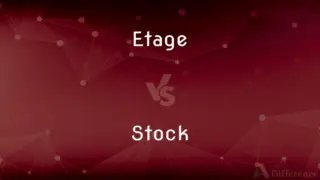Perpendicular vs. Transverse — What's the Difference?
By Fiza Rafique & Maham Liaqat — Updated on April 7, 2024
Perpendicular refers to lines or planes intersecting at a 90-degree angle, emphasizing orthogonality. Transverse denotes crossing or lying across, focusing on orientation rather than angle.

Difference Between Perpendicular and Transverse
Table of Contents
ADVERTISEMENT
Key Differences
Perpendicularity is a specific geometric condition where two lines or planes meet at exactly 90 degrees, creating what is known as a right angle. This relationship is fundamental in various fields, such as mathematics, physics, and engineering, signifying orthogonality and often indicating stability or perpendicular forces in physical contexts. On the other hand, transverse refers to something that lies or moves across something else. It is less about the precise angle of intersection and more about the direction or orientation of crossing. Transverse concepts appear in anatomy, describing structures crossing the body or parts of it, and in physics, describing waves or motions that are directed perpendicularly to the direction of propagation or main orientation.
While perpendicularity is strictly defined by the right angle, the concept of being transverse is broader and can involve various angles of crossing. Perpendicular lines or planes always intersect at a right angle, but transverse elements may intersect at any number of angles, as long as they cross or lie across each other.
In the context of waves, perpendicular can describe the orientation of electromagnetic waves’ electric and magnetic fields to the direction of wave propagation (such as in light waves). Whereas, transverse waves refer to waves where the motion of the medium is at right angles to the direction of the wave, applicable to both mechanical waves (like water waves) and electromagnetic waves.
Perpendicular interactions are often critical in constructing and engineering, ensuring that structures meet at right angles for stability and aesthetic purposes. In contrast, identifying transverse relationships can be crucial in understanding natural phenomena, such as the movement of tectonic plates or the propagation of waves through different mediums.
Comparison Chart
Definition
Intersecting at a 90-degree angle
Crossing or lying across
ADVERTISEMENT
Application
Geometry, engineering, physics
Anatomy, physics, general description
Importance
Indicates orthogonality and stability
Describes orientation or direction of crossing
Examples
Perpendicular lines in a square
Transverse waves in physics
Contexts
Often used in mathematics and construction
Used in various contexts including anatomy and wave physics
Compare with Definitions
Perpendicular
Meeting at or forming right angles.
The walls are perpendicular to the floor.
Transverse
Positioned or extending across something.
The transverse bar supports the weight across the frame.
Perpendicular
Describes the relationship between two lines which meet at a 90-degree angle.
The theorem states that a line drawn perpendicular to a base divides it into two symmetrical parts.
Transverse
Refers to structures crossing the body or parts of it.
The transverse abdominis muscle extends across the abdomen.
Perpendicular
Forces acting at right angles to each other.
The tension in the rope acts perpendicular to the direction of motion.
Transverse
Waves where oscillations are perpendicular to the direction of the wave's advance.
Light consists of transverse electromagnetic waves.
Perpendicular
Structures or elements meeting at right angles for stability.
The beams are set perpendicular to the ground for enhanced stability.
Transverse
Faults or features that cut across established patterns.
Transverse mountain ranges disrupt the prevailing direction of other ranges.
Perpendicular
Any instance of right angle formation.
Parking spaces are often perpendicular to the driving lane.
Transverse
Anything that crosses or intersects.
The pedestrian bridge is transverse to the roadway.
Perpendicular
In elementary geometry, the property of being perpendicular (perpendicularity) is the relationship between two lines which meet at a right angle (90 degrees). The property extends to other related geometric objects.
Transverse
Situated or extending across something
A transverse beam supports the dashboard
Perpendicular
At an angle of 90° to a given line, plane, or surface or to the ground
Dormers and gables that extend perpendicular to the main roofline
Transverse
Situated or lying across; crosswise.
Perpendicular
Denoting the latest stage of English Gothic church architecture, prevalent from the late 14th to mid 16th centuries and characterized by broad arches, elaborate fan vaulting, and large windows with vertical tracery
The Perpendicular style
The handsome Perpendicular church of St Andrew
Transverse
Something, such as a part or beam, that is transverse.
Perpendicular
A straight line at an angle of 90° to a given line, plane, or surface
At each division draw a perpendicular representing the surface line
Transverse
Situated or lying across; side to side, relative to some defined "forward" direction; perpendicular or slanted relative to the "forward" direction; identified with movement across areas.
Perpendicular
(Mathematics) Intersecting at or forming right angles.
Transverse
(anatomy) Made at right angles to the long axis of the body.
Perpendicular
Being at right angles to the horizontal; vertical.
Transverse
(geometry) of an intersection Not tangent, so that a nondegenerate angle is formed between the two things intersecting.
Perpendicular
Often Perpendicular Of or relating to a style of English Gothic architecture of the 1300s and 1400s, characterized by the use of fan vaulting and broad windows with many mullions.
Transverse
(obsolete) Not in direct line of descent; collateral.
Perpendicular
In a perpendicular position.
Transverse
Anything that is transverse or athwart.
Perpendicular
(Mathematics) A line or plane perpendicular to a given line or plane.
Transverse
(geometry) The longer, or transverse, axis of an ellipse.
Perpendicular
A perpendicular position.
Transverse
To lie or run across; to cross.
Perpendicular
A device, such as a plumb line, that is used in marking the vertical from a given point.
Transverse
To traverse or thwart.
Perpendicular
A vertical or nearly vertical line or plane.
Transverse
To overturn.
Perpendicular
(geometry) At or forming a right angle (to something).
In most houses, the walls are perpendicular to the floor.
Transverse
To alter or transform.
Perpendicular
Exactly upright; extending in a straight line toward the centre of the earth, etc.
Transverse
(obsolete) To change from prose into verse, or from verse into prose.
Perpendicular
Independent of or irrelevant to each other; orthogonal.
Transverse
Lying or being across, or in a crosswise direction; athwart; - often opposed to longitudinal.
Perpendicular
(geometry) A line or plane that is perpendicular to another.
Transverse
Anything that is transverse or athwart.
Perpendicular
A device such as a plumb line that is used in making or marking a perpendicular line.
Transverse
The longer, or transverse, axis of an ellipse.
Perpendicular
A meal eaten at a tavern bar while standing up.
Transverse
To overturn; to change.
Perpendicular
Exactly upright or vertical; pointing to the zenith; at right angles to the plane of the horizon; extending in a right line from any point toward the center of the earth.
Transverse
To change from prose into verse, or from verse into prose.
Perpendicular
At right angles to a given line or surface; as, the line ad is perpendicular to the line bc.
Transverse
Extending or lying across; in a crosswise direction; at right angles to the long axis;
Cross members should be all steel
From the transverse hall the stairway ascends gracefully
Transversal vibrations
Transverse colon
Perpendicular
A line at right angles to the plane of the horizon; a vertical line or direction.
Perpendicular
A line or plane falling at right angles on another line or surface, or making equal angles with it on each side.
Perpendicular
A straight line at right angles to another line
Perpendicular
A Gothic style in 14th and 15th century England; characterized by vertical lines and a four-centered (Tudor) arch and fan vaulting
Perpendicular
A cord from which a metal weight is suspended pointing directly to the earth's center of gravity; used to determine the vertical from a given point
Perpendicular
An extremely steep face
Perpendicular
Intersecting at or forming right angles;
The axes are perpendicular to each other
Parallel lines never converge
Concentric circles are parallel
Dancers in two parallel rows
Perpendicular
At right angles to the plane of the horizon or a base line;
A vertical camera angle
The monument consists of two vertical pillars supporting a horizontal slab
Measure the perpendicular height
Perpendicular
Extremely steep;
The great perpendicular face of the cliff
Common Curiosities
What does perpendicular mean?
Perpendicular means intersecting at or forming a right angle.
Can transverse lines be perpendicular?
Yes, transverse lines can be perpendicular if they intersect at a 90-degree angle.
How is transverse different from perpendicular?
Transverse implies lying or crossing across, without specifying the angle, unlike perpendicular, which specifically denotes a 90-degree intersection.
Is perpendicularity important in construction?
Yes, perpendicularity is crucial in construction for ensuring stability and aesthetic alignment.
Can a transverse feature be seen in anatomy?
Yes, transverse features in anatomy refer to structures that cross the body or its parts, like the transverse abdominis muscle.
Why are perpendicular lines important in physics?
They represent forces acting at right angles, crucial for understanding equilibrium, motion, and other physical phenomena.
What makes a wave transverse?
A wave is transverse if its oscillation is perpendicular to the direction of its propagation.
How do transverse waves differ from longitudinal waves?
Transverse waves oscillate perpendicular to the direction of wave propagation, whereas longitudinal waves oscillate in the direction of propagation.
How do engineers use the concept of perpendicularity?
Engineers use it to design buildings, bridges, and other structures, ensuring right angles for stability and load distribution.
What role does perpendicularity play in geometry?
It defines the relationship between lines, planes, and angles, forming the basis for many geometrical theorems and principles.
Are all transverse interactions physical?
Not necessarily; the term can describe abstract relationships, such as crossing ideas or concepts.
How is the term transverse used in everyday language?
It describes anything that crosses or is situated across something else.
Can perpendicularity affect a structure's integrity?
Absolutely, perpendicular joints and supports are often integral to a structure's strength and stability.
Do perpendicular lines have to intersect?
Yes, by definition, perpendicular lines intersect at a 90-degree angle.
What is a simple example of a transverse structure?
A simple example is a crossbeam in construction that lies across main supporting beams or structures.
Share Your Discovery

Previous Comparison
Etage vs. Stock
Next Comparison
Flintlock vs. MusketAuthor Spotlight
Written by
Fiza RafiqueFiza Rafique is a skilled content writer at AskDifference.com, where she meticulously refines and enhances written pieces. Drawing from her vast editorial expertise, Fiza ensures clarity, accuracy, and precision in every article. Passionate about language, she continually seeks to elevate the quality of content for readers worldwide.
Co-written by
Maham Liaqat















































